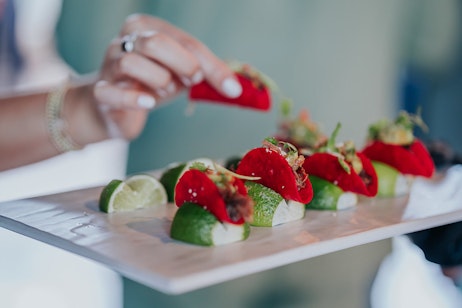Beyond the Plate: Creating Memorable Moments
In today's experience-driven event landscape, attendees crave more than just exceptional food—they desire engagement, storytelling, and memorable interactions, ensuring that food becomes a highlight of the event rather than just a necessity.
Good food is great; good food wrapped up in an immersive, photo-worthy, theatrical experience is better. This highly engaging form of food service is in high demand, too: Eventbrite found that 75% of diners believe it’s worth paying more for a one-of-a-kind experience.
Interactive stations that captivate
It’s no longer about traditional buffets and sit-down meals. Interactive dining experiences are on the rise. These setups not only engage guests but also create memorable moments, allowing them to connect with the food and the chef.
Today's most successful events incorporate chef-attended action stations where culinary artists create personalized dishes while engaging directly with guests. From made-to-order risotto or ceviche bars to liquid nitrogen ice cream stations, these interactive elements become focal points that encourage movement, conversation, and shared experiences.
Additionally, off-premise doesn’t mean off-limits when it comes to spectacle. Live fire cooking stations, roaming food stations such as caviar carts, grazing tables, seafood ice bars, tasting events, and torched desserts are turning events into Instagram gold.
Additionally, instead of letting guests grab food from a static station, themed interactive service is also on the rise. These stations often offer communal, customizable menu options, like a make-your-own chocolate bar station, where guests can choose flavors and toppings.
Encouraging movement is also trending. For example, orchestrate a five-senses event where guests rotate in small groups throughout interactive food and beverage stations: at one, perhaps a cocktail is “mixed” using the resonance of a Tibetan Singing Bowl (sound) and at another, guests can dip their crudites into “edible paint” splattered across canvasses (sight).
Customers are no longer satisfied with passive dining experiences—they want to be engaged and entertained.
“Incorporating live action to any event allows the guests to interact with the experience, taking it to a level where it awakens the senses,” says Chef Sean Holden with Puff ‘n Stuff Events & Catering (Orlando, FL). “Rather than sitting at a table and having a beautiful plate brought to you, a guest can see, smell, hear, and watch the creation get built right before them, immersing them in the finished dish.”
Collaborative creation
Invite guests to become part of the culinary process. Guided mixology sessions, hands-on pasta making classes, DIY garnish bars, or foraging, where attendees can help collect the ingredients or decor for their event, give attendees agency in crafting their perfect bite. This participation creates a sense of ownership and personalization that static buffets simply cannot match.
Immersive storytelling through food
Every dish has a story, and by embracing that story, events can transform dining into a full-fledged journey, inviting people to step beyond passive dining and into an experience that stimulates all the senses with each element adding layers of excitement and engagement.
Today's events can weave compelling narratives throughout the dining experience, transporting guests beyond the plate, turning a simple meal into an unforgettable story.
The most successful immersive experiences incorporate carefully curated touchpoints—from staff attire and serving vessels to ambient sounds and lighting—all working in harmony to support the central narrative. Additionally, these immersive dining experiences should be grounded in authenticity. Whether highlighting local producers, showcasing cultural heritage, emphasizing sustainability practices highlighting seasonal ingredients, or local history, the narrative should feel genuine and purposeful. For example, QR codes can be incorporated at food stations linking to short videos about ingredient sourcing or chef interviews, creating layers of engagement for curious guests.
Immersive storytelling invites people to step beyond passive dining and into an experience that stimulates all the senses with each element adding layers of excitement and engagement.
Service with style
Innovations in food and beverage delivery at events have evolved to offer both efficiency and spectacle, making dining an interactive experience. Today’s event guests aren't content with traditional butler passing or station design anymore; they’re looking for creativity, innovation, and the “wow” moment.
One standout method is the revival of hawker trays, where roaming vendors equipped with wearable serving stations move through crowds, offering bites and drinks on the go. These mobile food stations reduce congestion at food stations while keeping attendees engaged with an interactive, nostalgic experience. Hawker trays themselves can even go beyond the expected through the use of lighting, color, and unique vessels.
Another exciting trend is the use of conveyor belts to deliver food directly to guests. At high-end festivals and VIP areas of sporting events, diners can pick from a rotating selection of small bites and beverages without needing to wait in line. Hanging food displays, such as suspended tomahawk carving stations or zipline-style delivery systems, add an element of surprise and spectacle to the experience.
Beverage trucks and trailers that incorporate built-in tap systems have long been popular, and now this has given rise to “wine trikes,” a pedal-powered mobile wine bar that brings beverages directly to guests.
Technology-enhanced dining
Augmented reality menus, projection-mapped dining surfaces, and synchronized lighting that changes with each course are transforming how guests experience food. These technological touches create multisensory moments that amplify the emotional impact of your event while providing endless social media-worthy opportunities.
Some high-tech events have even introduced robotic arms that pass food to guests with precision and flair. These innovations not only enhance efficiency but also add an element of entertainment, making food service an integral part of the event itself.
The takeaway
In all aspects of life, we’re demanding bigger, better, more vibrant experiences that we won’t forget—and why should the food we eat be any different? We’re in an era of sensory overload, and it’s time to lean into that.
The most successful events today blend exceptional cuisine with meaningful interaction, thus creating gatherings that engage all senses and leave lasting impressions. In a world where experiences are valued above possessions, interactive culinary moments have become the gold standard for memorable events.



